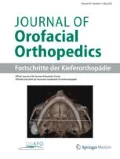Zusammenfassung
Das Behandlungsziel der Kieferorthopädie ist es, den Patienten neben einer guten Ästhetik für lange Zeit eine optimale Funktion zu sichern. Daher genügt es nicht, bei der Diagnostik und bei der Therapieplanung von einer statischen Situation, nämlich der habituellen Interkuspidation auszugehen. Vielmehr wird eine ausführliche Funktionsdiagnostik mit geeigneten Methoden erforderlich, um
-
1.
nicht von falschen Voraussetzungen auszugehen.
-
2.
die Indikation unter Berücksichtigung der individuellen Funktion zu ermöglichen.
-
3.
die individuell optimale Behandlungsmethode zu wählen und
-
4.
das individuell optimale Behandlungsergebnis zu sichern.
Die klinische Erfahrung zeigt nämlich, daß ein funktionelles Optimum fast immer mit einem ästhetischen Optimum verbunden ist, ein ästhetisches Optimum aber keineswegs immer mit einem funktionellen. Vor allem sollte das individuelle Adaptationsvermögen in seiner Größe nicht überschätzt werden. Es ist vorstellbar, daß eine funktionsdiagnostische Grundlagenforschung bei Kindern und Jugendlichen die Grenzen des individuellen Adaptationsvermögens aufzeigen und damit kalkulierbar machen kann.
Summary
The aim of orthodontic treatment is to ensure an optimal functioning for the patient besides aesthetic satisfaction. For this the diagnosis and planning of treatment cannot only be based on the static situation of habitual intercuspidation.
It is necessary to develop suitable methods for a functional diagnosis so that
-
1.
the diagnosis is not based on false premisses.
-
2.
an indication is possible taking the individual function into account.
-
3.
an optimal course of treatment for the individual can be chosen and
-
4.
an optimal degree of success in the therapy can be ensured.
Clinical experience shows that optimal function is nearly always linked with an aesthetic optimum, but that the converse is by no means always true. It is important above all not to overestimate the individual ability to adapt. It is possible to imagine basic research into functional diagnosis for children and young people by charting the limits of the individual's ability to adapt and thus making these calculable.
Résumé
Le but d'un traitement d'orthopédie dento-faciale est d'assurer pour longtemps au patient, non seulement une esthétique mais une fonction satisfaisante. Aussi il ne suffit plus de se baser sur la situation statique de l'occlusion habituelle pour établir diagnostic et plan de traitement. Bien plus, un diagnostic fonctionnel établi d'après des méthodes appropriées devient-il nécessaire afin
-
- de ne pas partir sur de fausses hypothèses.
-
- d'individualiser l'indication de traitement en rapport avec la fonction.
-
- de choisir la méthode de traitement optimale dans le cas envisagé.
-
- et d'assurer un résultat optimal pour le cas traité.
En effet, l'observation clinique a montré que si un résultat fonctionnel optimal est pratiquement toujours lié à un résultat esthétique optimal, la réciproque et loin d'être vraie. Avant tout, on ne doit pas surestimer le degré de la capacité d'adaptation du patient. On a de bonnes raisons de penser que la recherche fondamentale en matière de diagnostics fonctionnels chez les enfants et chez les adolescents sera en mesure de déterminer les limites individuelles de la capacité d'adaptation et, par la même, de les rendre calculables.
Schrifttum
Huffmann, R. W., J. W. Regenos: Principles of occlusion. H & R Press, Ohio 1973.
Ingervall, B.: Retruded contact position of mandible. A comparison between children and adults. Odont. Revy 15 (1964), 130.
Ingervall, B.: Recording of retruded positions of mandible in children. Odont. Revy 19 (1968), 65.
Mottl, W., H. Th. Schrems: Funktionsanalytische Untersuchungen von Klasse-II-Anomalien. Dtsch. zahnärztl. Z. 32 (1977), 378.
Perry, H. T.: Mandibular function: An orthodontic responsibility. Amer. J. Orthodont. 67 (1975), 316.
Ross, I. F.: Occlusal contacts of natural teeth. J. prosth. Dent. 32 (1974), 660.
Schrems, H. Th.: Bessere pantografische Zeichnungen. Dtsch. zahnärztl. Z. 29 (1974), 1096.
Schrems, H. Th., G. Schrems-Adam: Funktionelles Optimum kieferorthopädischer Therapie. Fortschr. Kieferorthop. 37 (1976), 359.
Stöckli, P. W.: Die Reaktionsfähigkeit des mandibulären Gelenkknorpels auf orthopädische Stimulation während der Wachstumsphase. Schweiz. Mschr. Zahnheilk. 82 (1972), 335.
Stöckli, P. W.: Die Reaktionsfähigkeit des mandibulären Gelenkknorpels auf orthopädische Stimulation wahrend der Washstumsphase. Schweitz. Mschr. Zahnheilk. 82 (1972), 558.
Stuart, C.: Pers. Mitt. Meeting der European Academy of Gnathology, Amsterdam 1976.
Author information
Authors and Affiliations
Additional information
Mit 9 Abbildungen
Rights and permissions
About this article
Cite this article
Schrems, H.T., Schrems-Adam, G. Wertigkeit der Funktionsanalyse. Fortschritte der Kieferorthopädie 38, 302–311 (1977). https://doi.org/10.1007/BF02172153
Issue Date:
DOI: https://doi.org/10.1007/BF02172153

